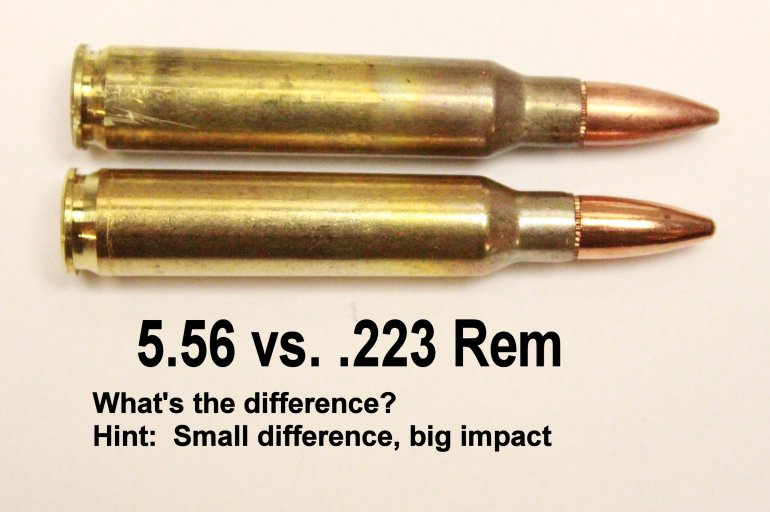
Maybe you just got a new rifle or want to sight in your latest scope. If you’re grabbing ammo for your .223 or 5.56 rifle or “pistol,” assuming you can find any on the shelf anywhere, you might want to take a closer look, especially if you prefer greater accuracy and safety.
Hardly discernible to an untrained eye, most folks can’t tell the difference between a 5.56 NATO round and a .223 Remington round by just looking at the loaded cartridge. Looking closely at the headstamp on the cartridge may be the only way to tell them apart. Both types of rounds may fit in your gun. Does that mean it is safe to use either? It is certainly not recommended!
Using the incorrect ammo for your gun can result in inaccuracy, malfunctions, and excessive wear. In rare but extreme cases, using the incorrect ammunition can cause irreparable damage to the gun or injury to the shooter.
Let’s take a look at some of the specification differences between the 5.56 and the .223 Rem.:
- Rated Pressure: while actual pressures can vary with each gun and each individual round, the 5.56 NATO is generally rated at 58,000 psi while the 223 Remington comes in at 55,000 psi
- Throat Length: the chamber of a 5.56 NATO gun has a much longer throat of 0.059 inches, while the 223 Remington has less than half that measuring in at 0.025 inches
- Throat Diameter: while the 5.56 NATO has a longer throat, the diameter is actually slightly smaller (0.224 inches) compared to the 223 Remington (0.226 inches)
- Throat Angle: the chamber inside of a 5.56 NATO gun also has a shallower throat angle coming in around 1.2 degrees where the 223 Remington is closer to 3.1 degrees
- Case Capacity: 5.56 NATO rounds have slightly thicker brass shells which decreases the volume available for propellant (gunpowder) to 28.5 grains of water versus the 223 Remington which can hold just a bit more at 28.8 grains of water
The key is the varied pressure. This is the peak pressure force created when each round is shot, and it is different enough to throw things off. The very slight casing and chamber dimensional differences such as throat length, throat thickness, and the thickness of the brass casing are all just enough to increase the pressure created by the 5.56 NATO.

Generally speaking, a 5.56 NATO round has a higher peak pressure than the 223 Remington. This is compensated for by the differences in the gun chambers designed for a 5.56 NATO versus a .223 Remington. The distance between the mouth of the cartridge and where the rifling contacts the bullet (freebore plus the leade distance) is longer in a 5.56 NATO chamber. This additional volume and space is designed to take the higher pressures.
Ok, so what does all that actually mean?
- Can I fire 5.56mm ammunition with my 5.56 NATO? Yes.
- Can I fire 223 Rem ammunition with my 223 Remington? Of course.
- Can I fire 223 Rem ammunition with my 5.56 NATO? Technically yes, but the bullet velocity and accuracy will be reduced.
- Can I fire 5.56mm ammunition with my 223 Remington? Not recommended! Those high pressures can do some unintended damage.
Keep in mind that due to the tolerances when manufacturing, two different guns of the same exact model could have barrel diameters that are ever so slightly different. This affects the pressure created inside the chamber. So your particular gun may not build up to pressures quite this high, or alternatively it could be even higher.
So make sure you buy the correct ammunition for your 5.56 NATO or 223 Remington firearm. If you have both types, make sure you store the appropriate ammunition next to the corresponding gun in your gun safe. If you are wondering which gun safe is best for you, it should be chosen based on what you need it for. For example, do you need one for travelling, concealment, etc.? From there, you narrow your options based on preferences and price.
So to recap: Is the pressure difference between the 5.56 NATO and 223 Remington rounds going to damage your gun if you fire even one incorrect round? Probably not, but is that something you want to risk? So make sure you grab the right one, but if it is a life or death situation, go ahead and grab whichever is closer.
Author Bio:
Richard Douglas is a long-time shooter, outdoor enthusiast and technologist. He is the founder and editor of Scopes Field, and a columnist at The National Interest, Cheaper Than Dirt, Daily Caller and other publications.

I have read a lot of articles about the differences and this one is the clearest and most concise of any of them. Now, nobody should knowingly load that 5.56 round into a chamber made for the 223. Good Job.
Buy a Rock River with a Wylde chamber and shoot whatever you have
Rock river? NO way, NO how, NO thank you, traitors.
And how is a Rock River not American? Made outside of the Quad Cities.
Hugh, glad you remember! For others – Rock River, along with Springfield, sold out gun owners and FFL gun dealers regarding the Gun Dealer Licensing Act, saying they wouldn’t publicly object to the Act, as long as they received a “carve out for themselves” of the Act’s requirements. The Act is now Law in Illinois. Half of Illinois FFLs quit, turning in their licenses rather than face the costs involved in compliance. Thanks Rock River and Springfield!
OK, to return to the original point let me rephrase.
Buy a rifle from your preferred manufacturer, make sure it comes with a Wylde chamber and shoot whatever brand of either .223 or 5.56 you have without checking the headstamp.
[…] There are a ton of options out there when it comes to red dot optics for your AR-15. […]